This post may contain affiliate links.Please read our disclosure policy.
German Bread Dumplings are a perfect side dish for anything with gravy! This traditional Bavarian recipe made from stale bread tastes so delicious with roasts or a simple mushroom sauce.
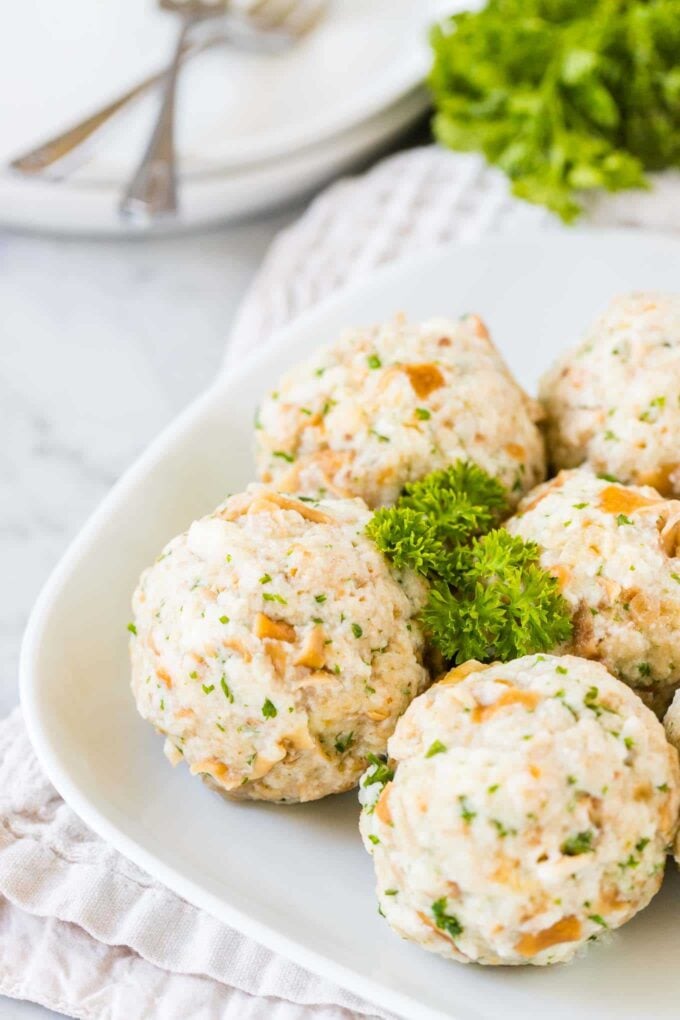
Bread dumplings are a traditional Bavarian side dish, made from bread, milk, onion, eggs, and herbs. When cooked, the dumplings are airy, have a tender texture, and go with anything saucy, like a roast, goulash, Jagerschnitzel, but they also taste delicious served with mushroom sauce for a vegetarian option.
If you like stuffing, you will love this traditional German recipe! The ingredients and texture is kind of similar. Semmelknödel are pretty easy to make, much easier than Kartoffelklöße (potato dumplings) in my opinion and they go perfect with anything that comes with gravy or sauce! Serve them with a roast, goulash, and more!
Why is this recipe the BEST
- We made this recipe as approachable and foolproof as possible, so you can make them at home just as easily as my Oma in Germany.
- We’ve been making bread dumplings for years but before posting this recipe we did more research to make sure to give you the BEST and most TRADITIONAL recipe. We talked to our moms, grandmothers, and my cousin who is a chef at his family’s Bavarian restaurant and they all shared their tips and tricks.
- North American bread is different from German bread, less crust, more fluffiness. The recipe I came up with, uses bread crumbs to adjust the dough moisture, so it works with any bread.
How to make Bread Dumplings
Detailed measurements and instructions can be found at the bottom of the page on the printable recipe card.
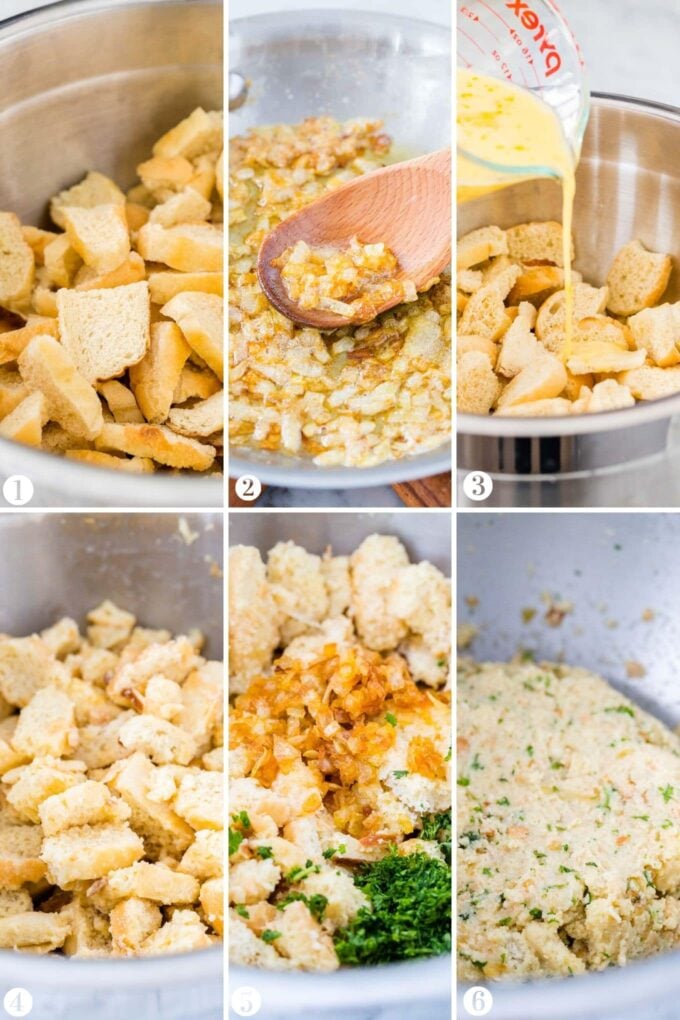
Ingredients used in German Semmelknoedel
- White bread or rolls: Kaiser buns work best. The buns get sliced and need to dry out before they can be used, similar to stuffing bread.
- Milk: To moisten the bread. Some recipes use hot milk, but in my experience, the dough is easier to handle, with cold milk.
- Eggs: Help to bind the knoedel together.
- Onion: I always saute the onions until golden brown because that way they have more flavor, taste milder, and are cooked through.
- Butter: Adds more flavor than oil.
- Fresh parsley: Adds flavor! Fresh parsley works best.
- Breadcrumbs: To adjust the moisture of the mixture. I recommend using unseasoned breadcrumbs so they don’t change the flavor of the Semmelknoedel.
Instructions
- Prep Bread: Cut the buns or bread into slices and let them dry out overnight or longer.
- Fry Onion: In a small skillet over medium-low heat, melt the butter, add the chopped onions, and saute until golden brown, about 10 minutes.
- Add and wait: Mix the eggs, milk, and salt. Pour the mixture over the sliced bread.
- Combine: Mix with your hands or a spatula until all bread is coated.
- Add other ingredients: Add onion with the butter from the pan and chopped parsley to the bread mixture and knead it with your hands until no dry parts remain.
- Shape: Form a ball and cut into 8 equal slices. With wet hands, shape each piece into a ball, slightly smaller than a tennis ball.
- Cook: In a big pot, bring water to a simmer and let Bread Dumplings simmer for 20 minutes on low. Remove dumplings with a slotted spoon. Serve with gravy.
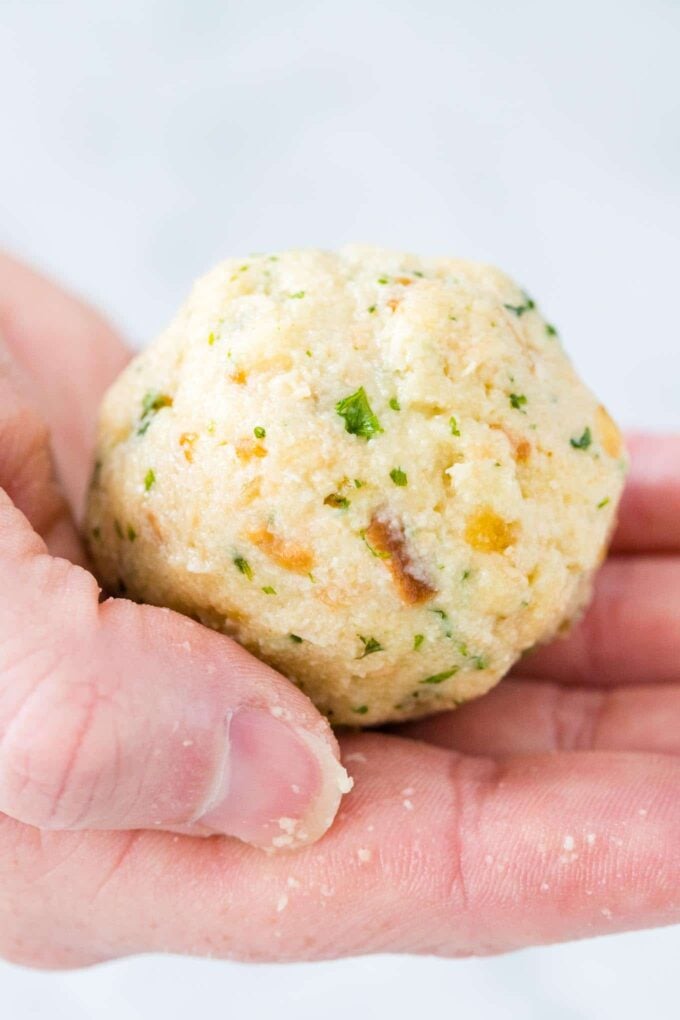
Which Bread works best?
- Kaiser buns: When I make these here in Canada, I find the best approach is to buy kaiser buns (or other buns). The ratio of crust to crumb is better this way than when using a loaf of bread.
- French bread: A loaf of french bread works well too.
- Unseasoned Stuffing bread: Around Thanksgiving, my local grocery store sells day-old stuffing bread. This is convenient as it is ready to use.
- Pretzel buns or pretzels: Instead of the kaiser buns, you can buy pretzel buns and use them instead of white bread. This gives the Knödel a slight pretzel taste, which goes great with roasts.
FAQ
- How to prep bread for Bread Dumplings? I prefer to cut the bread in slices instead of cubes. This way it is easier to moisten everything and the dough sticks better together. You want to do this a few days in advance, cut the buns in half and cut each half into thin slices. Put the sliced bread in a big bowl and let it sit without a lid on the counter for about 3 days, tossing them every day so they dry out evenly.
- How to store leftovers? Put them in an airtight container and store them in the fridge.
- What to do with leftovers? Cut into bite-sized pieces or slices. In a large skillet, fry some bacon and onion. Add the Knödel slices and brown. Finally, add two eggs and fry until the egg is cooked. This is called a Knödelgröstl in German.
- How can you prevent the Knödel from falling apart? Make sure the mixture is firm and a bit sticky. It is also very important that the water doesn’t boil, keep it at a simmer just below the boiling point. If you are unsure, make a test knoedel and cook it before making the other knoedel. To completely avoid the risk, make serviettenknödel instead.
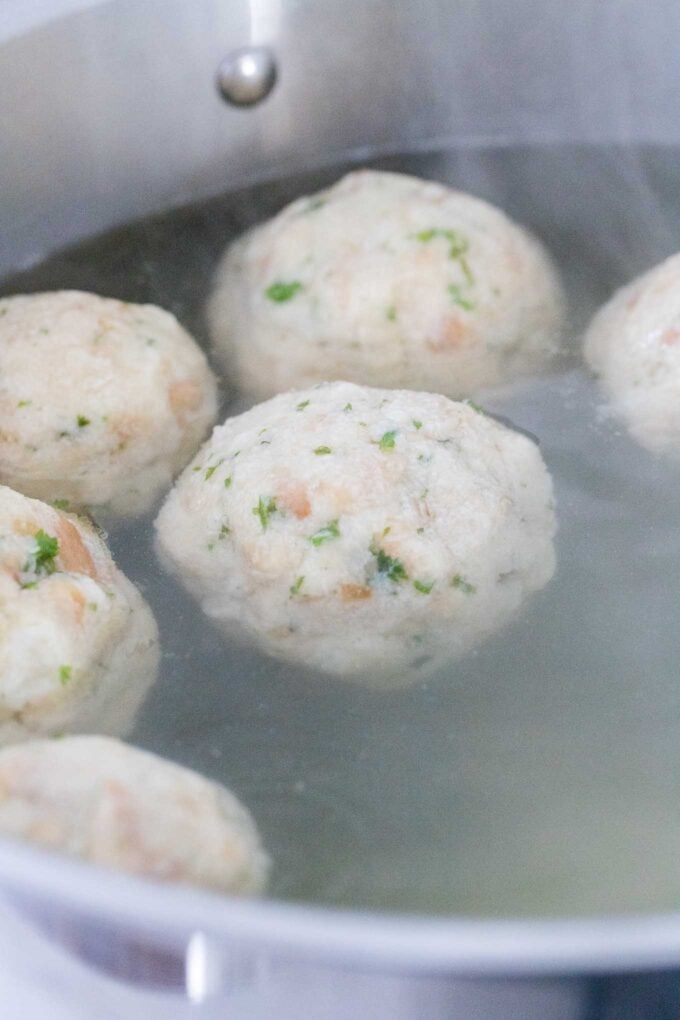
Delicious Variations of this recipe
- Speckknödel: Instead of frying the onions in butter, fry 1/2 cup of chopped bacon in a pan until it starts to brown. Add the half cup of onions and fry until golden. Add this mixture to the dough.
- Breznknödel: Instead of the Kaiser buns, use pretzel buns or pretzels. This gives the knödel a slight pretzel taste.
- Serviettenknödel: Instead of rolling the Knödel by hand, divide the mixture into two, then shape into two logs. Wrap them twice in plastic wrap and then in aluminum foil. Simmer in salt water for 20 minutes, then remove foil and slice. Pictured below.
- Potato Dumplings: Called Kartoffelkloesse in German. They are also shaped into balls but are made from potatoes instead of bread.
- Czech Dumplings: Knedlíky are flour-based dumplings that are shaped into a log and steamed. They are a staple of the Czech cuisine.
- Leberknoedel (Liver Dumplings): These are different from bread dumplings and are usually served in soup. They are made from ground liver, bread, eggs, parsley, and spices.
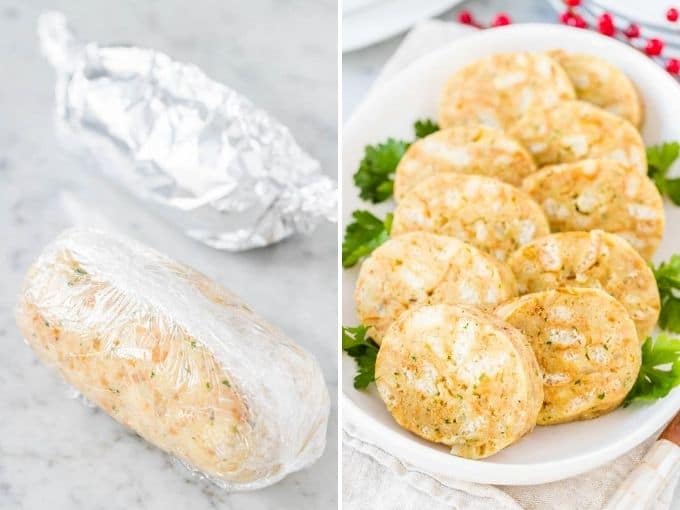
What goes with Semmelknödel
Traditionally Semmelknödel can be served as a side dish or main dish! In Germany, you can also often find knoedel with gravy (“Kloss mit Sosse”) on the kid’s menu, it’s a childhood favorite of mine.
As a side dish: Bread dumplings go with anything saucy like roasts, pork tenderloin, or Goulash. German roasts are often served with a dark sauce that is made with beer and caraway seeds, which compliments the taste of the dumplings very well.
As the main dish: Bread Dumplings are also often served as a main dish topped with mushroom sauce (coming soon). This is a popular vegetarian dish that is on the menu of many German restaurants and so easy to make at home.
More German recipes
- Black Forest Cake: A classic! This cake is always a hit and perfect for special occasions!
- German Apple Cake: This simple cake is easy to make, perfect for beginner bakers.
- Red Cabbage: Braised cabbage is a popular side dish in Germany with roasts!
- Pork Hock: A classic Bavarian Biergarten treat
- Spaetzle: These tiny egg noodles are also a popular side dish.
- Schnitzel: Learn how to make the best German Schnitzel, just like my Oma makes them!
- Bavarian Pretzels: A classic snack
- Apple Strudel: A perfect dessert for your Oktoberfest party!

Bread Dumplings (Semmelknoedel)
Ingredients
- 3 large eggs
- 1 cup whole milk
- 1/2 tsp salt
- 8 cups stale bread cubes, about 12 ounces
- 1/4 cup unsalted butter
- 1/2 cup chopped onion
- 1/4 cup chopped fresh parsley
- 1/4 cup breadcrumbs, as needed
- 1 Tbsp salt, for the water
Instructions
- Mix the eggs, milk, and salt. Pour the mixture over the sliced bread. Mix with your hands or a spatula until all bread is coated. Let it sit for a few minutes.
- In a small skillet over medium-low heat, melt the butter, add the chopped onions, and saute until golden brown, about 10 minutes.
- Add onion with the butter from the pan and chopped parsley to the bread mixture and knead it with your hands until no dry parts remain. The dough should be firm and slightly sticky. If it’s too wet, add breadcrumbs, 1 Tbsp at a time and knead until combined.
- Form a ball and cut into 8 equal slices. With wet hands, shape each piece into a ball, slightly smaller than a tennis ball.
- In a big pot, bring water to a boil, add 1 Tbsp of salt. Lower heat until water is barely simmering. Using a slotted spoon, transfer bread dumplings to the pot.
- Cover the pot and let Bread Dumplings simmer for 20 minutes on low. Remove dumplings with a slotted spoon. Serve with gravy.
Notes
- Bread: Kaiser buns or french bread work best (check post for other options), cut into slices, and leave out on the counter for a few days to become stale. Unseasoned stuffing bread works too. Don’t use croutons, they are too dry. If you don’t want to wait that long or forgot to prep the bread, you can dry it in a low oven for 30 minutes.
- Parsely: If you’re not a big fan of parsley, you can reduce the amount of parsley to two tablespoons.
- Onion: You don’t have to brown the onions, many recipes only call for sauteeing them until translucent, but I find browning them adds more flavor and tastes better.
- Shaping: Wet your hands when you shape the knoedel so they don’t stick to your hands. Don’t overwork the dough.
- Cooking: Don’t let the water boil! It should just barely simmer.
- Leftovers: Slice leftover bread dumplings and fry in butter with onion and bacon.
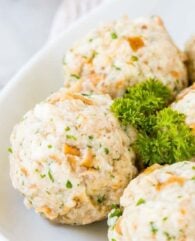
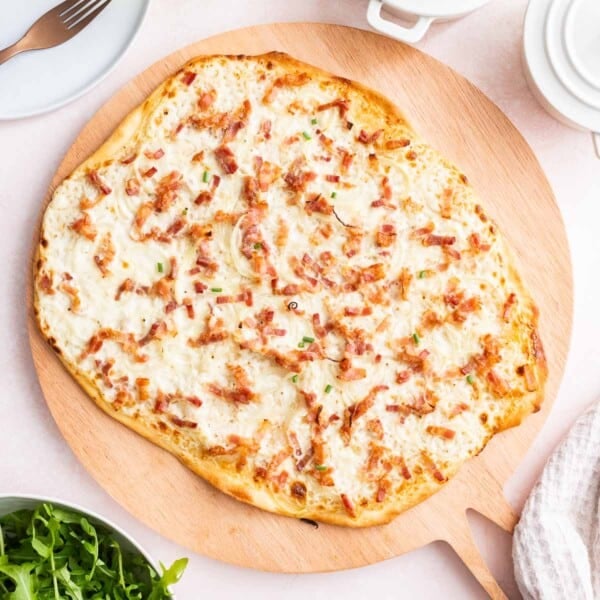
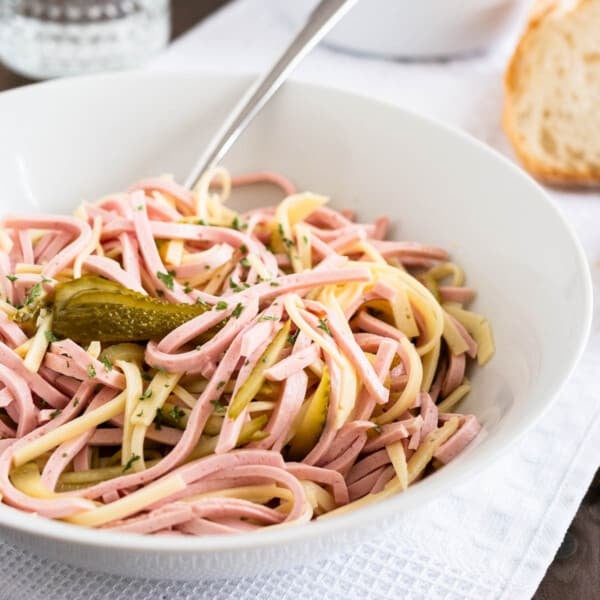

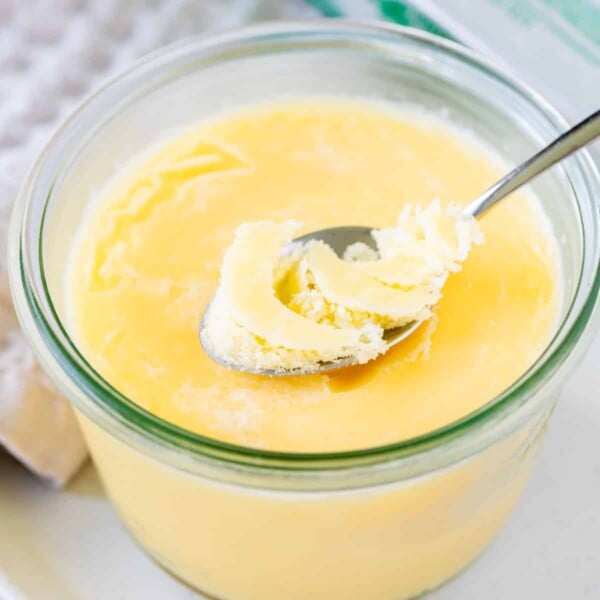






I omitted the onion and parsley because my grandma and mom never added onion so I wanted to have them taste the same. I added the butter and used breadcrumbs instead of flour and they were delicious!
As you can see I am not German. My Sister’s Mother in law was from Bavaria and I have her recipe for bread dumplings and also for Spaetzle. Iam going to make yours as I have several recipes boxes to look through and at 88 I don’t have time
I still do my own housework and Laundry.
.
I was born in Salzburg, Austria. My Austrian grandmother taught me how to cook. In Austria, Semelknoedel are steamed and not cooked in water. Also we add a small amount of cream of wheat. This makes the knoedel much lighter.
In Germany the potato dumplings are cooked in salted water. My mother was German.
My grandma was from austria…she made this all the time but I just never asked her for the recipe. I will try these for Christmas dinner!
Just returned from Austria and attempting to make leberknodelzuppe. I’ve started the process and now have to wait until tomorrow to finish so which should I do? 1) mix the dough together and keep in the frig then cook the dumplings tomorrow, 2) keep ingredients separate and prepare all tomorrow (the bread cubes are soaking in milk but that’s the only thing prepped right now), or 3) cook the dumplings today and reheat the soup tomorrow.
Just wondering what your best guess is for how to move forward. Thank you for your recipes, can’t wait to try the mushroom sauce, this was prepared for us in a small village with mushrooms the cook at picked herself in the hills. It was fantastic!!
Lauri, Leberknoedel are not the same as Semmelknoedel (bread dumplings). Semmelknoedel are not served in soup and don’t contain liver (Leber). So you might want to look for a Leberknoedel recipe. But to answer your question, I recommend cooking the bread dumplings right away. The dough doesn’t keep well and bread cubes in milk will get too soft if you let them sit overnight. You can slice the bread dumplings on the next day and fry them in a bit of butter, that’s what we always do with leftovers.
Just like my mom’s and oma’s. Wonderful.!
I have been searching for this recipe for a long time, since the person who made them is long gone.
This recipe is spot-on.
For that matter, all your German recipes are spot on… my mom used to make them, learning them, having passed thru Germany after the war.